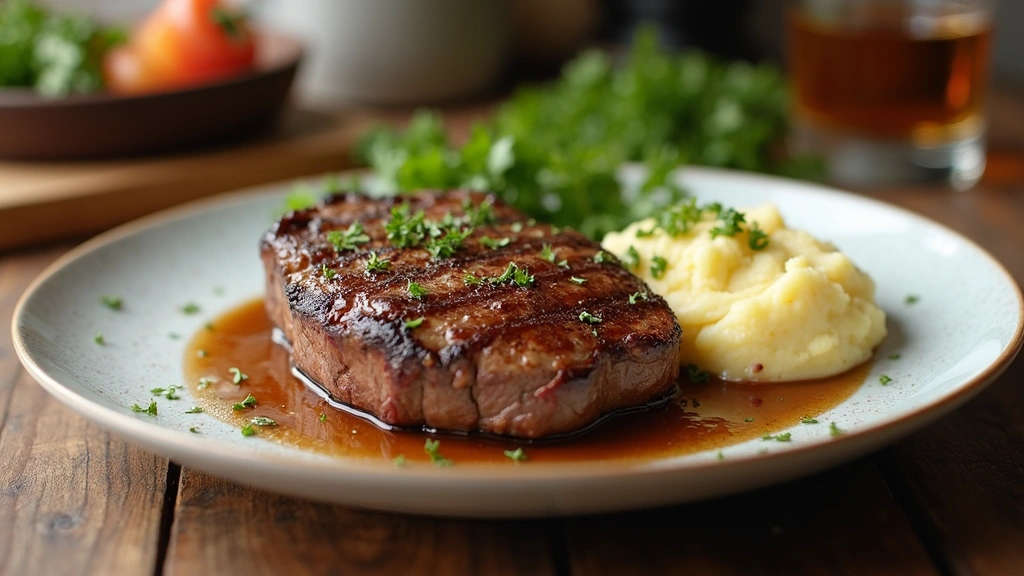Steak with Mashed Potatoes is a timeless combination that never fails to satisfy.
The rich, juicy flavors of a perfectly cooked steak pair beautifully with the creamy, buttery smoothness of mashed potatoes.
This classic dish evokes comfort and nostalgia, often bringing back memories of family dinners and celebratory meals.
Whether you’re a seasoned cook or a beginner in the kitchen, this recipe offers a straightforward approach to achieving restaurant-quality results at home.
Perfect for any season, this dish is equally at home as a weekday meal or a special occasion centerpiece.
Prepare to impress your guests or family with this harmonious duo that celebrates simplicity and flavor.
The History and Cultural Significance
• Steak with Mashed traces its origins to Europe, where it was originally created by blending local beef with root vegetables.
• The dish evolved over decades as chefs refined cooking techniques and experimented with seasonings, eventually becoming the beloved version we know today.
• In American culture, this dish traditionally appears at family gatherings and holiday meals, symbolizing warmth and togetherness.
• While many variations exist across different regions, the authentic version maintains a perfect balance of tender steak and creamy potatoes that sets it apart from imitations.
Recipe Overview
Nutritional Information (per serving)
Essential Equipment Guide
Cast Iron Skillet: A cast iron skillet is essential for achieving a perfect sear on your steak. Its ability to retain and evenly distribute heat makes it ideal for cooking steak to perfection. Alternatives include a heavy-duty stainless steel pan.
Potato Masher: This tool is vital for achieving the desired creamy texture in your mashed potatoes. While a fork or electric mixer can work, a masher allows for better control.
Instant-Read Thermometer: Ensuring your steak is cooked to the correct temperature is crucial. An instant-read thermometer provides accuracy, helping to avoid undercooked or overcooked steak. Look for one with a quick response time.
Ingredients
For the Steak
|
|
| Amount | Ingredient | Notes |
|---|---|---|
| 4 8-ounce | ribeye steaks | room temperature |
| 1 tablespoon | olive oil | for searing |
| 2 teaspoons | salt | to taste |
| 1 teaspoon | black pepper | freshly ground |
For the Mashed Potatoes
| Amount | Ingredient | Notes |
|---|---|---|
| 4 large | russet potatoes | peeled and quartered |
| 1/2 cup | milk | warmed |
| 1/4 cup | butter | melted |
| 1 teaspoon | salt | to taste |
For the Garnish
| Amount | Ingredient | Notes |
|---|---|---|
| 2 tablespoons | fresh parsley | chopped |
| 1 tablespoon | chives | chopped |
Preparation Methods
Searing: Searing is a technique that involves cooking the steak at high heat to create a flavorful brown crust. This process locks in juices and enhances flavor. To master searing, ensure your pan is hot before adding the steak.
Mashing: Achieving the perfect mashed potatoes requires understanding the balance between smoothness and texture. Use a potato masher and gradually incorporate milk and butter for creamy results.
Resting: Allowing the steak to rest after cooking is crucial. This technique lets the juices redistribute throughout the meat, resulting in a juicier steak. Resting for at least 5 minutes under foil is recommended.
Step 1: Prepare Ingredients

Gather all your ingredients and equipment.
Ensure steaks are at room temperature and potatoes are peeled and quartered.
Warm the milk and melt the butter in separate bowls.
Chop the parsley and chives for garnish.
Step 2: Boil Potatoes

Place the quartered potatoes in a large pot and cover with water.
Bring the water to a boil over high heat.
Reduce heat to a simmer and cook until potatoes are tender, about 15 minutes.
Drain the potatoes and set aside.
Step 3: Preheat Skillet

While the potatoes are boiling, preheat a cast iron skillet over medium-high heat.
Add olive oil and heat until shimmering.
Ensure the skillet is hot before adding the steak.
This will help create a golden crust.
Step 4: Season Steaks

Pat the steaks dry with paper towels.
Season both sides generously with salt and pepper.
Ensure the seasoning is even and covers the entire surface.
This will enhance the flavor and help form a crust.
Step 5: Sear Steaks

Place the steaks in the hot skillet without overcrowding.
Sear for 3-4 minutes on each side until a crust forms.
Use tongs to flip the steaks gently.
Cook to desired doneness, using a thermometer to check temperature.
Step 6: Rest Steaks

Remove the steaks from the skillet and place on a plate.
Tent the steaks with aluminum foil to keep warm.
Let them rest for at least 5 minutes.
This allows the juices to redistribute, ensuring a juicy steak.
Step 7: Mash Potatoes

Return the drained potatoes to the pot.
Add melted butter, warmed milk, and salt.
Use a potato masher to blend until smooth and creamy.
Adjust seasoning to taste if needed.
Step 8: Plate and Garnish

Place a serving of mashed potatoes on each plate.
Slice the rested steak and arrange next to the potatoes.
Sprinkle chopped parsley and chives over the top.
Serve immediately for best flavor.
Critical Timing and Temperature Guide
Searing Steak: Sear each side of the steak for 3-4 minutes at medium-high heat until a brown crust forms. Avoid moving the steak too soon to ensure proper searing.
Boiling Potatoes: Boil potatoes for 15 minutes or until fork-tender. Overcooking can lead to waterlogged potatoes, making mashing difficult.
Resting Steak: Allow steak to rest for at least 5 minutes after cooking. This step is crucial for juicy results and should not be skipped.
Pro Tips for Steak with Mashed
• Ingredient Selection: Choose high-quality ribeye steaks and fresh russet potatoes for the best texture and flavor.
• Preparation Secret: Dry the steaks thoroughly with paper towels before seasoning to ensure a great crust.
• Temperature Management: Let steaks come to room temperature before cooking for even heat distribution.
• Texture Enhancement: Use a potato ricer for ultra-smooth mashed potatoes if available.
• Flavor Layering: Add garlic or herbs to the mashed potatoes during cooking for enhanced flavor.
• Make-Ahead Strategies: Prepare mashed potatoes in advance and reheat gently over low heat, stirring in additional milk if necessary.
• Restaurant-Quality Finishing Touches: Brush steaks with melted garlic butter before serving for added richness.
• Equipment Optimization: Preheat your skillet well to ensure the perfect steak sear.
Troubleshooting Common Issues
• Steak Overcooked: This occurs if the skillet is too hot or cooking time is too long. Use a thermometer to check doneness and adjust heat accordingly.
• Mashed Potatoes Too Lumpy: Under-mashing or using the wrong potatoes can cause this. Use russet potatoes and mash thoroughly.
• Steak Undercooked: Make sure the skillet is preheated and use an instant-read thermometer to ensure proper doneness.
• Flavors Unbalanced: Insufficient seasoning can lead to bland results. Taste and adjust salt and pepper as needed.
• Steak Too Tough: This can occur from overcooking or choosing the wrong cut. Opt for ribeye or similar tender cuts.
• Mashed Potatoes Too Watery: Avoid over-boiling and ensure potatoes are drained well before mashing.
Variations and Regional Differences
• French Style: Includes a red wine reduction sauce and uses shallots and garlic in the mashed potatoes for added depth.
• Italian Variation: Features a balsamic glaze on the steak and incorporates parmesan cheese into the mashed potatoes.
• American Southern Style: Often includes gravy made from pan drippings and adds cream cheese to the mashed potatoes for richness.
• Asian Fusion: Uses soy sauce and ginger marinade for the steak and adds wasabi to the mashed potatoes for a kick.
Food Science Behind the Recipe
• Maillard Reaction: This chemical reaction occurs during searing, creating rich flavors and aromas by browning the steak's surface.
• Starch Gelatinization: When potatoes are cooked, starches absorb water and swell, creating the creamy texture of mashed potatoes.
• Protein Denaturation: As steak cooks, proteins denature, changing structure and texture. Understanding this helps achieve desired doneness.
Frequently Asked Questions
What's the most common mistake people make when preparing Steak with Mashed Potatoes? Overcooking the steak or under-seasoning the potatoes can detract from the dish's flavor. Proper timing and seasoning are key.
Can I use another cut of steak? Yes, other tender cuts like filet mignon or sirloin can be used, though cooking times may vary.
How can I make mashed potatoes ahead of time? Prepare them in advance and reheat gently, adding a splash of milk to restore creaminess.
What's the best way to reheat leftover steak? Reheat in a low oven or under a broiler briefly to maintain juiciness without overcooking.
How do I know when the steak is done? Use an instant-read thermometer: 130°F for medium-rare, 140°F for medium.
Can I make this recipe dairy-free? Substitute butter and milk in the mashed potatoes with plant-based alternatives like olive oil and almond milk.
Why did my steak come out tough? Toughness can result from overcooking or not allowing the steak to rest before slicing.
Serving and Presentation Guide
• Traditional Presentation: Serve steak sliced on a platter with mashed potatoes in a separate bowl, garnished with herbs.
• Modern Plating: Stack sliced steak over a bed of mashed potatoes, drizzle with sauce or garnishes.
• Family Style: Serve on a large platter for sharing, with steak sliced and potatoes in a communal bowl.
• Individual Plates: Present each serving with steak and potatoes on individual plates, garnished individually for elegance.
Conclusion
This classic Steak with Mashed Potatoes recipe combines satisfying flavors with straightforward preparation.
Whether you're looking to impress guests or enjoy a comforting meal, this dish delivers every time.
Embrace the tradition and treat yourself to a culinary experience that's both timeless and delicious.

